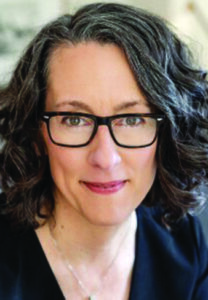By Melissa Russell
Several years ago, when attorney Stephanie Hausman and her husband became foster parents, they experienced firsthand the intricacies of the New Hampshire juvenile system. The nine-year-old whom they later adopted had a team of dedicated professionals on her side, all very active and attentive to her needs, but Hausman saw deficiencies.
“There were so many people interacting with her. She had to gear up emotionally, and she knew she was expected to say everything was fine,” Hausman says. “What she needed was a therapeutic relationship that was just for her, someone she could tell anything to, and it would be okay. It became really important to look at all the systems from her perspective.”

This personal experience was a revelation for Hausman, a former public defender. It led her to the Children’s Law Center of New Hampshire in Portsmouth, where executive director Lisa Wolford hired her to serve as the Center’s first litigation director.
Formed in July 2022, the CLC, conceived of, created, and founded by Wolford, provides legal representation and social services advocacy to children growing up in poverty who are at the center of Children in Need of Services (CHINS), delinquency, and abuse and neglect matters; who have special education needs; or who are otherwise at risk. It is the only nonprofit organization providing comprehensive advocacy and legal services for children in the state.
According to the New Hampshire Department of Health and Human Services, approximately 900 children are served in state foster care in any given year. The New Hampshire Fiscal Policy Institute reports the child poverty rate increased between 2019 and 2021, rising from about seven percent in 2019 to more than nine percent in 2021. About 23,000 Granite Staters under the age of 18 lived in poverty during those years.
Poverty, violence, abuse or neglect at home, or growing up in a household where there are substance use or mental health problems or parental separation can undermine a child’s sense of safety, stability, and bonding, according to the Centers for Disease Control and Prevention-Kaiser Permanente study on adverse childhood experiences, known as ACES.
Lisa Wolford said because court-involved and other at-risk children face a wide range of legal and social services challenges, the Center provides comprehensive advocacy across all areas.
Wolford worked with the state’s Attorney General’s Office overseeing an investigation of child abuse-related crimes at the youth detention facility in Manchester. That was when she realized the child welfare and delinquency systems were “broken.”
“It made me really sad and angry that our state hadn’t figured out a way to do better by children, especially the most vulnerable children who are poor kids without a lot of support in their lives. I decided I was going to do something that produced better outcomes for children,” Wolford says.

Hausman says the system is “driven by the goal of keeping a child alive. It overlooks the importance of maintaining relationships with the family, schools, siblings, and other important relationships.”
Wolford says she did not wish to denigrate those who serve within the juvenile system but said it could serve children in better ways. She indicates the child welfare system blames children for behavior that is the product of trauma, even when they have experienced abuse and neglect. Removing children from their home and community takes care of public safety concerns, but eventually they will age out and “rocket straight into the adult criminal justice system.”
“We don’t tend to think of children in delinquency context as victims,” Wolford says. “What we tend to do is blame children for behavior that is the product of trauma. We wind up paying to prosecute them, defend them, house them in institutions, and then pay to prosecute and defend them as adults and house them in jails and prisons.”
Wolford says data determining the effectiveness of outplacements is nonexistent.
“Research isn’t great about how institutions serve children and prepare them for productive, happy lives where they can be productive members of society, where we worry less about paying for mental, medical, and substance abuse costs,” she says.
The Children’s Law Center currently focuses on children in the age range of 11 to 15, who will soon age out of the system and have the capacity to communicate in their own interests. They have histories of trauma and tend to be part of dysfunctional, often chaotic families with their own histories in the child welfare system. Some have been homeless, and some have experienced food insecurity.
At present, the two attorneys are providing legal representation for a small pool of children while developing policies, creating a board of directors, hiring an accountant, and otherwise getting a solid infrastructure in place.
“We have spent a lot of time investigating the law, incorporating social science on ACES and childhood trauma, and developing ways of advocating for children with trauma histories that harms them less,” Wolford says. “Court systems by their nature can be traumatic for children. Removing a child from their home is traumatic whether or not it is the best course of action. A lot of our work has been presenting arguments to the court that there are ways of serving children that are less harmful than, for example, institutionalization.”
Wolford says their next hire will be a social worker.
New Hampshire Supreme Court Justice Gary Hicks called the creation of the Law Center “absolutely wonderful,” and said the attorneys are “destined to succeed.”
“They are both very remarkable lawyers who come to the stage with instant credibility, and there is a lot of buzz about what they’re doing among the legal community,” Justice Hicks says. “One thing that is fairly clear to everyone, is the system needs more resources, and not just monetary. We see it happening with some decisions coming out of our courts – everyone knows it needs to be better.”
